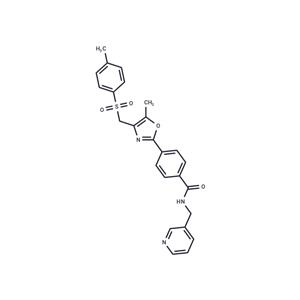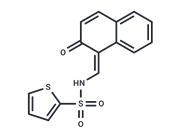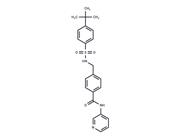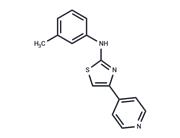| Name | STF-118804 |
| Description | STF-118804, a highly specific NAMPT inhibitor, reduces the viability of most B-ALL cell lines with an IC50 of less than 10 nM. |
| Cell Research | Human cell lines or lineage negative cord blood cells were seeded into 96-well plates (6×105 cells per milliliter). Compounds are added in increasing concentrations, and cells are incubated at 37°C/5% CO2 for 72 hours. To detect viability, CellTiter-Blue reagent is added at 1:10 dilution, and plates are incubated for 4 hours at 37°C/5% CO2 prior to reading on a Flexstation II 384 or a Synergy H1 reader at an excitation of 555 nm and emission detection of 590 nm. Cell viability is also measured by CellTiter-Fluor. The cell-permeable ?uorogenic peptide substrate GF-AFC reagent is added at 1:2 dilution, and plates are incubated for 30 min at 37°C/5% CO2 prior to reading on a Synergy H1 reader at an excitation of 380 nm and emission detection of 505 nm. Cord blood cells are enumerated on a hemocytometer, and cell viability is assessed with trypan blue exclusion dye. Inhibitory concentration (IC50) is calculated using Prism software. Primary patient samples are plated in 96-well plates and treated with increasing concentrations of STF-118804 for 48 hours at 37°C in 5% CO2. WST-1 reagent is added to the culture medium (1:10 dilution), and absorbance is measured at 450 nm using a Bio-Rad model 680 microplate reader. All assays are performed in triplicate. IC50 is calculated using CalcuSyn version 2.0 software.(Only for Reference) |
| Kinase Assay | Enzyme Assays: The enzymatic activities of NAMPT and NMNAT are measured using in vitro kits and using the Two-Step Method per manufacturer's instructions. Compounds, NAMPT and/or NMNAT enzymes, and their substrates are mixed and incubated at 30°C for 1 hour. Reagents for the indicator reaction (Wst-1) are then added, and absorbance is read at 450 nm every 5 min at 30°C on a Tecan In?nite M100 multimode plate reader. |
| In vitro | STF-118804 reduces the viability of B-ALL cell lines containing MLL chromosomal translations, with IC50 values in the low nanomolar range. In addition, leukemic samples from ?ve pediatric ALL patients are also sensitive to STF-118804 in the low nanomolar range. STF-118804 induces leukemia MV411 cell apoptosis without antecedent cell cycle arrest. [1] |
| In vivo | STF-118804 (25 mg/kg twice daily, s.c.) improves survival in an orthotopic xenotransplant model of high-risk acute lymphoblastic leukemia, and effectively depletes leukemia-initiating cells. [1] |
| Storage | Powder: -20°C for 3 years | In solvent: -80°C for 1 year | Shipping with blue ice. |
| Solubility Information | DMSO : 46.2 mg/mL (100 mM)
|
| Keywords | Inhibitor | inhibit | Pre-B cell colony enhancing factor | Apoptosis | Nicotinamide phosphoribosyl transferase | PBEF | NAMPT | Visfatin | STF-118804 |
| Inhibitors Related | Stavudine | 5-Fluorouracil | Acetylcysteine | Kaempferol | Myricetin | Sodium 4-phenylbutyrate | L-Ascorbic acid | Dextran sulfate sodium salt (MW 4500-5500) | Metronidazole | Sorafenib | Tributyrin | Lidocaine hydrochloride |
| Related Compound Libraries | Highly Selective Inhibitor Library | Glycometabolism Compound Library | Target-Focused Phenotypic Screening Library | Bioactive Compound Library | Inhibitor Library | Stem Cell Differentiation Compound Library | Metabolism Compound Library | Bioactive Compounds Library Max | Anti-Metabolism Disease Compound Library | Anti-COVID-19 Compound Library |

 United States
United States



